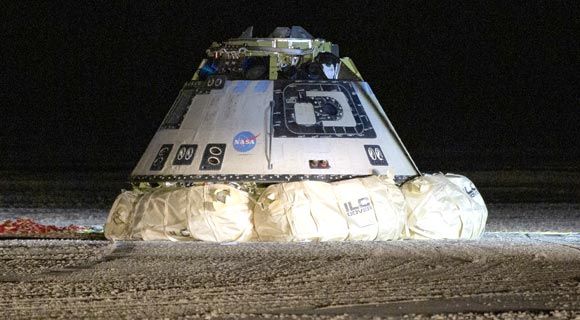Boeing’s CST-100 Starliner crew capsule made history on Sunday but this time it was for a success. The empty crew capsule failed to make it to its intended orbit following the spacecraft’s first uncrewed test launch on Friday but after doing some math engineers were able to bring it to a soft landing on the desert of the White Sands Missile Range in New Mexico. It was the first time a manned capsule had been recovered on land in the U.S. “Watching the landing was a thing of beauty today,” NASA Administrator Jim Bridenstine told Boeing and NASA flight controllers at Mission Control in Houston, according to NASA commentators.
The capsule spent a couple of days orbiting the planet after a timing error put it at the wrong altitude. It was supposed to dock at the International Space Station for a week and then return empty on the all-important shakedown. The capsule was launched on an Atlas V rocket at 6:36 a.m. EST from Space Launch Complex 41 at Cape Canaveral Air Force Station in Florida.
“When the spacecraft separated from the launch vehicle, we did not get the orbital insertion burn that we were hoping for,” said Jim Bridenstine on Friday. “It appears as though the mission elapsed timing system had an error in it and that anomaly resulted in the vehicle believing that the time was different than it actually was.” Bridenstine highlighted that the issue was one of automation, suggesting that a crew would likely have been able to correct the issue in time to continue the mission as planned and that even if they had not, they would not have been in danger.



































I’ll be expecting it to arrive at KBAF some time next week. Oy.
Not a good year for Boeing.
Not a good year, indeed! The Aerospace Division was Boeing’s last hope for some good news in 2019. Bridenstine suggested that if astronauts were on board, they could have overridden the automation and successfully continued the mission. Imagine, a human performing better than a robot system! I wonder who gets stuck with the bill for a failed launch?
“Imagine, a human performing better than a robot system!”
Yeah – that worked so well with the MCAS.
The idea that Spam-in-a-can would instantly become aware that they were on their way to an incorrect orbit, let alone instantaneously correct it, is laughable.
Much like the Hubble lens disaster, humans screwed up this event.
“imagine, a human performing…” – let’s do just that! It’s humans that designed and built the systems. If one unravels MCAS, SpaceShuttle, Hubble and numerous others there will be an uncomfortable amount of project management and non-technical (human factor) root causes within the chain of events. In the end it takes human intervention to correct issues, be it on the fly – or after the pieces are gathered out of the dust. In safety management databases I would wager a bet that there are more cases of humans saving the day than not…the events that make the news are usually the ones where things have gone too far ‘south’.